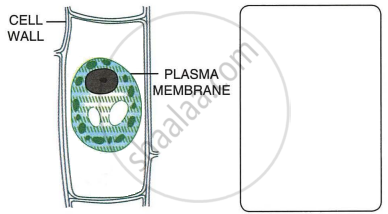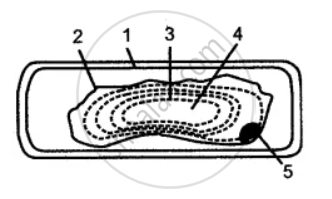Advertisements
Advertisements
प्रश्न
Deplasmolysis occurs when a plasmolysed cell is placed in ______.
विकल्प
Concentrated salt solution
Tap water
Concentrated sugar solution
Hypertonic salt solution
उत्तर
Deplasmolysis occurs when a plasmolysed cell is placed in Tap water.
Explanation:
One hypotonic solution is tap water. Because the concentration of water outside the cell is higher, water moves within the cell. Subsequently, the cell expands and turns turgid. This is known as deplasmolysis.
APPEARS IN
संबंधित प्रश्न
A plant cell may burst when :
The diagram below represents a process in plants. The setup was placed in bright sunlight. Answer the following questions:

a) Name the physiological process depicted in the diagram.
Why was oil added to the water?
b) When placed in bright sunlight for four hours, what do you observe with regard to the initial and final weight of the plant? Give a suitable reason for your answer
c) What happens to the level of water when this setup is placed in:
- Humid conditions?
- Windy conditions?
d) Mention any three adaptations found in plants to overcome the process mentioned in (i).
e) Explain the term ‘Guttation’.
Give reason for the following:
It is better to transplant seedlings in a flower-bed in the evening and not in the morning.
Give reason for the following:
A plant cell, when kept in a hypertonic salt solution for about 30 minutes, turns flaccid.
A leaf cell of a water plant was placed in a liquid other than pond water. After sometime, it assumed a shape as shown below:

- Give the term for the state of the cell it has acquired.
- Name the structure which acts as a selectively permeable membrane.
- Comment on the nature (tonicity) of the liquid surrounding the cell.
- Name any one feature of this plant cell which is not present in an animal cell.
- Redraw in the space provided, the diagram of the cell if it is soon placed in ordinary water for some time.
The below diagram represents a plant cell after being placed in a strong sugar solution. Guidelines 1 to 5 indicate the following:
1. Cell wall
2. Plasma membrane.
3. Protoplasm
4. Large vacuole
5. Nucleus
Study the diagram and answer the questions that follow :
(i) What is the state of the cell shown in the diagram?
(ii) Name the structure which acts as a selectively permeable membrane.
(iii) If the cell had been placed in distilled water instead of a strong sugar solution which features: would not have been present?
(iv) If the cell in the diagram possessed chloroplasts where would these be present?
(v) Name any one feature of this plant cell which is not present in animal cells.
Name the following:
The process by which wilting or drooping of leaves occurs.
Name the following:
The condition in which the contents of a cell exert pressure against the cell wall making it distended.
Fill in the Blank
The condition opposite to turgid is ___________.
When the cells of a plant are fully distended, the condition is called ______.
